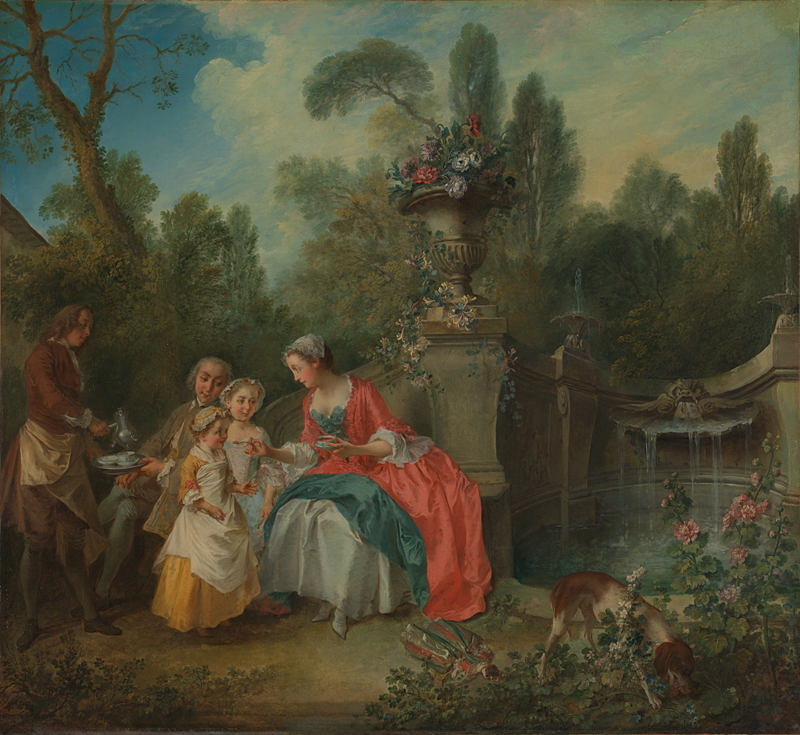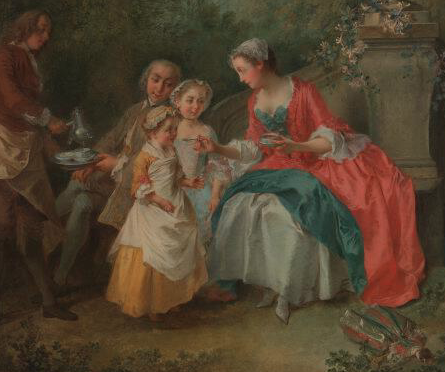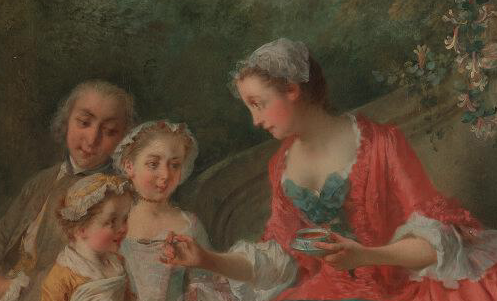
Day 26 – Nicolas Lancret, ‘La Tasse de Chocolat’, probably 1742, National Gallery, London.
It’s Easter Monday, which is not a religious festival (unless you’re Orthodox, in which case Easter isn’t until next Sunday anyway), but a chance for the banks to have a holiday because they wouldn’t have been open yesterday anyway, so couldn’t have a day off then. I think that’s the logic. What better time to sit back and enjoy the chocolate? That’s why I’ve chosen this painting – traditionally known as ‘La Tasse de Chocolat’ – the Cup of Chocolate. However, as I have mentioned before (#POTD 9) most titles we have for paintings before the 19thCentury are either simply descriptions of what is painted, or nicknames applied in the 19th or early 20th Centuries which have never gone away. In the case of some 18th Century French paintings the situation is different – I might get back to that another day! In this case someone at the National Gallery had the original idea of actually looking at the painting and then looking at the real world, and realised that the servant on the far left is not holding a chocolate pot, but a coffee pot. So, I’m afraid that I’m cheating today, as the official title of this painting is now ‘A Lady in a Garden having Coffee with Children’ – which, it turns out, is the title it had when it was first exhibited at the Paris Salon of 1742. Tant pis!
Lancret was one of the most important followers of Watteau, who is, sadly, slightly out of favour. His romanticising views of the life of leisure have come to seem a little pointless to some, but that is a great pity, as they are beautifully and delicately painted, with a wonderful sense of melancholy. Lancret appears to be quoting from him here, as two of the figures look remarkably similar to two in Watteau’s late, great masterpiece, ‘L’Enseigne de Gersaint’ – and yes, you’re right, it was a shop sign (though not for very long). Having said that, it is possible that Lancret has spent so much time looking at Watteau’s paintings that the older artist’s reflexes had become his own: the references might not be deliberate at all.
What is undoubtedly similar is the location. The official title says that they are in a garden – and a very fine one it is too. As a family unit, these people are undoubtedly entitled to gather together in a group larger than two, and I assume that, if the servant lives in, then there is no reason why he shouldn’t be there as well. And if this is their garden, they are truly blessed. There’s been too much ‘park shaming’ – as a friend called it – recently. It’s fine for those people with gardens to say ‘oh, they shouldn’t all be out in the parks’, but there are so many people living in cramped flats, often with too many other people: we must find a way to give them more space! With a garden like this one, there is no need – it looks more like a park anyway.
In Watteau, part of the magic is the ambiguity. You never know exactly where you are. The landscapes look like the countryside, but there are classical statues scattered around – it could be a park, or a run down estate, which has been left to go wild. Similarly, you can never be quite sure who the people he paints are. Are they off-duty actors? If so, why are they wearing their costumes out in the park? And why do they have costumes of different eras? The images are entirely poetic… and I will talk about one of them soon! Back to Lancret: he cuts down on the ambiguity, and keeps our feet just that little bit more on the ground. This could be a garden – an incredibly large one – or it could be a park, in good condition. The fountain flows into the circular pond, honeysuckle climbs up the wall, and flowers bloom in the vase. The Ecologist tells me they are all cultivars, by the way, double versions, more blousy than the natural forms. There is nothing unsophisticated about this garden.

The flowers appear to have been grown to accessorize with Madame’s outfit – that little ‘ping’ of deep salmon pink lifts our eyes to the top of the vase, and then back down to the mother’s dress. The yellow and white of the honeysuckle harmonize with the clothes of her younger daughter. Mum holds the coffee in her left hand (yes, I’d prefer it if it were chocolate, just for today, but it’s better that it’s coffee!), and delicately holds a spoonful towards the child, little finger suitably erect. The girl’s face is a joy – how exciting, to try coffee for the first time! But the parents aren’t taking any chances. The buttercup-yellow dress has been entirely swathed with an apron. If you think it’s hard to get coffee stains out now, just think how impossible it would have been in 1742.

It’s at this point that you might start to think, ‘But this is madness!’ Deliberately giving coffee to a young child? Surely you want to keep them calm and collected? Luckily, they have an enormous garden to run around in (and back then they didn’t need to socially isolate), but the last thing you would want if you were having a quiet breakfast in the garden is caffeine-pumped offspring. More important than this, though: how will the child turn out? Imagine the horror of appearing in public with children who were unsophisticated! And the sophisticated thing was to take coffee in the morning, and after lunch. This girl is learning what it means to grow up.

There’s a very good clue to this – the girl’s doll has been discarded, and lies, face down on the path. It is time to put away childish things. The doll’s dress has the same colours as the mother’s – deep salmon, jade green and ivory. But it’s in a different style: not just the stripes, but the cut, which is far more formal. And the dog? Well, it’s ignoring the proceedings entirely, grubbing away, ignoring the hollyhocks as well. But then, we know that dogs are not as sophisticated as humans.
It is a charming, delightful painting. It may appear inconsequential, but Lancret has clearly lavished attention on the composition. The trees in the top left lead our eyes down to the family group, the diagonal from the bottom right corner, through the dog, leads to the interaction between mother and child, and the sloping wall behind the mother’s shoulders follows her gaze towards the expectant girl.

The father – and the servant – are in an earthy brown which helps them to fade into the background. After all, what do men know about bringing up girls? The focus is definitely on the mother – and the colours across the painting remind us she is there.
Enjoy your gardens, if you have them, and maybe give the people in the parks more space, as they might not. And enjoy your chocolate. Or coffee. Or, even better, both.
Thank you so much for these daily treasures, I look forward to them so much !
LikeLike
Oh, it’s a pleasure – I am glad you are enjoying them!
LikeLike